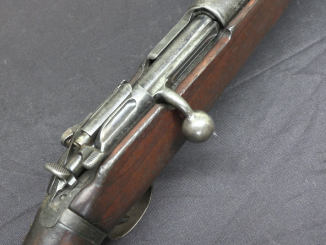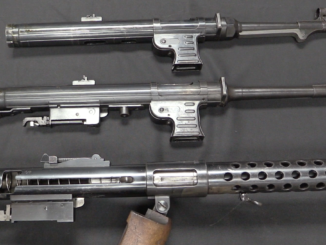It did not take long for some of the handling problems of the model 1879 Reichsrevolver to become apparent, and the result was a redesign to the model of 1883. These new guns retained the exact same lockwork was the 1879 pattern, but with a shorter barrel and redesigned frame and grip. The 1883 model revolver would serve as the German Empire’s standard sidearm until the adoption of the P08 Luger, and was used by officers and enlisted men alike – although officers would often buy nicer models on the commercial market, such as the double action example in this video. The two examples in this video are half of a lot containing no less than four model 1883 Reichsrevolvers over at Rock Island.
Related Articles

Bolt Action Rifles
Looking a Gift Horse in the Mouth
So, I was browsing through the catalog for Rock Island Auction’s upcoming Premier Auction (I’ll have more next week on the various neat things available), and found one item in particular that jumped out at […]

Bolt Action Rifles
The Hungarian Alternative: G98/40 Rifles in German Service
The German Wehrmacht was always hungry for more rifles during World War Two, and adopted substitute designs made in friendly (or subservient) countries when possible. Almost all of these were minor variations on the Mauser […]

Submachine Guns
The Schmeisser MP41: A Hybrid Submachine Gun
Most people think that the MP41 is simply an MP40 in a wooden stock, but this is actually not the case – and unlike the MP40, the MP41 can be accurately called a Schmeisser – […]

The double-action model is a great improvement, but still no ejector rod? The Colt Peacemaker had been around for years!
Double action models sometimes have ejectors very similar to the Colt 1873 SA. The sample in video has also two screws at right in front of cylinder for mounting of an optional ejector.
Not bad. With an ejector rod on a lanyard around your neck, I wouldn’t discount these as a service weapon.
Whoa, I thought the lanyard was supposed to go around your wrist so that you wouldn’t lose the revolver while on horseback and so enemies couldn’t steal your gun.
Actually, the lanyard was attached to your right-hand epaulet strap. Its purpose was that if you let go of the weapon, for whatever reason, it would end up hanging about even with your holster and not hit the ground. It comes in very handy if you suddenly need both hands for controlling a skittish horse, to name just one example.
As for weapon retention in a scrum, the SOP there is to stick the muzzle in the scrummer’s face and pull the trigger.
If you’re out of ammunition, hit him with it; that big two-and-a-half pound revolver makes a very effective “blunt instrument”.
A sharp, hard poke in the middle with the muzzle will take the wind out of somebody right on the spot, in most cases, and a typical downward “sap strike” to the head can easily result in a skull fracture and/or concussion. A muzzle-thrust or -swing impacting on the temple tends to be fatal.
No, close-quarters battle is not a game.
cheers
eon
Errr, no. I meant the EJECTOR ROD/STICK on a lanyard around your neck.
Oops. Sorry.
Fought in a lot of cavalry set-to’s astride a charger and with revolver on a lanyard have you? I mean you lecture Cherndog there like an avuncular old hussar, you do.
I have a soft spot for the M1883, especially the commercial D/A guns.
They’re so homely they’re cute.
It’s easy to imagine some Bavarian gendarme emptying his into Frankenstein’s monster to little effect.
I’ve long thought that the Creature’s “invulnerability” was over-estimated. Considering how Frankenstein created him, a bullet in the heart or brain should have killed him just as dead as it would anybody else. As usual, Hollywood mangled the story. Hammer got it closer to the original.
R.I.P Christopher Lee (27 May 1922- 7 June 2015)
cheers
eon
The monstrous cylinder lurches on yet, in the Ruger LCR series of double-action revolvers…
My wife’s late great-grandfather was issued one of these in WWI in his Bavarian artillery unit…
Why didn’t you review the pistol in the lot with ejector rod? Rather than the double action one you did look at.
People ( and governments full of people ) are slow to accept new ideas.
The Starr revolver company almost went bankrupt with their double action cap and ball revolver. When they introduced their second model, a single-action of similar design, sales picked up enough for the company to become successful.
I have seen a 1883, chambered for Italian 10.35mm. It took a while to figure out chambering, since 1879 model fitted .44 Russian w/o problems (and was quite accurate with it), and this one did not…
I vaguely recall a passage in ‘Slaughterhouse 5’ in which one of the ‘escaped’ (more like abandoned) prisoners in the ruins of Dresden is described as having armed himself with an ‘old cavalry revolver with bullets the size of a robin’s egg’, I think I’ve found the culprit.
I realize that this is very old, but on seeing how quickly one can remove the cylinder on this model (with just the spring-loaded pin), it struck me that the quickest reload method might have been to remove the cylinder, knock out the empty cartridges and reload before re-inserting the cylinder.